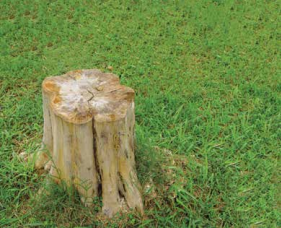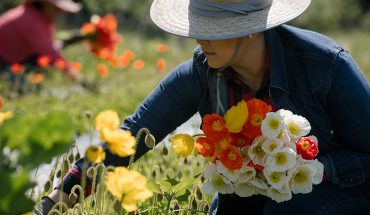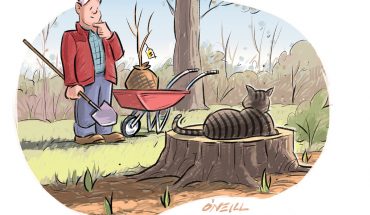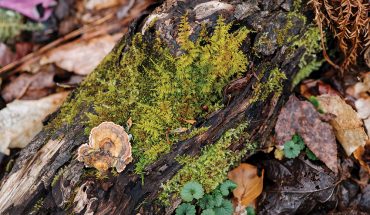A gardener’s fondness for his Japanese maple becomes a bittersweet reminder of life’s impermanence.
by Jim Dodson
Last month, I returned from my first trip since the start of the pandemic to discover a baffling mystery at home.
The leaves of a beautiful Green Dragon Japanese maple I’d raised from a mere seedling appeared to suddenly be dying. Arching gracefully over the side driveway, the rare seven-foot beauty was the star of my garden. It had never been more vibrant than the day I departed for a week out West, lush and green with lots of bright spring growth. But suddenly, inexplicably, those delicate new leaves were limp and withering.
A friend who knows his ornamental trees pointed out that a freakish, late-season cold snap might be the culprit. The leaves of nearby hydrangea bushes were also severely burned, but were already showing signs of recovery.
“I think you should simply leave it alone. Give the tree water and maybe a little spring fertilizer and let things take their course,” he said. “Nature has a way of healing her own.”
His theory seemed plausible. I’ve built and maintained enough gardens in my time to know that nature always holds the upperhand. Sometimes unlikely resurrections happen when you least expect them.
So I waited and watered, trying to push the thought of losing my spectacular Green Dragon out of my mind. Perhaps by some miracle it would come back to life.
As I went about other tasks in the garden — mulching and weeding perennial beds and transplanting ostrich and woodland ferns to my new shade garden — I thought about how the sudden death of a spring pig provided writer E. B. White intense grief and something of a personal epiphany, inspiring one of his most affecting essays in 1948.
Following a struggle of several days to heal his mysteriously ailing young pig — such an ordeal blurs the passage of time, the author expressed — White, accompanied by his morbidly curious dachshund, Fred, walked out one evening to check on the patient, hoping for the best: “When I went down, before going to bed, he lay stretched in the yard a few feet from the door. I knelt, saw that he was dead, and left him there: his face had a mild look, expressive neither of deep peace nor of deep suffering, although I think he had suffered a good deal.”
The young pig was buried near White’s favorite spot in the apple orchard, leaving his owner surprised by the potency of his own grief. “The loss we felt was not the loss of ham but the loss of pig,” White recounts. “He had evidently become precious to me, not that he represented a distant nourishment in a hungry time, but that he had suffered in a suffering world.”
Life, of course, is full of unexpected compensations. It’s possible that the grief White suffered with the loss of his pig was the literary world’s gain. Four years later, the author crafted a tale of a barn spider that saves a charming young pig, Wilbur, from slaughter by crafting upbeat messages in her web. It became an instant American classic, and Charlotte’s Web continues to rank among the most beloved children’s book of all time.
I don’t know if a failed effort to save a spring pig bought “in blossom time” is anything like trying to save a young Japanese maple I’d raised from a seedling, but the sadness of its sudden loss combined with a palpable sense that I’d somehow failed my tree followed me around like Fred the dachshund for weeks, a reminder of life’s mystery and bittersweet impermanence. It didn’t help matters, I suppose, that I couldn’t even bring myself to dig
up the deceased tree and cart it out to the curb for the weekly refuse crew. At this writing, as lush summer green explodes all around, the beloved tree stands like a monument to my botanical incompetence or simple bad luck. The autopsy is incomplete. The verdict is still pending.
Gardeners and farmers, of course, experience dramas of life and death — and sometimes unexpected rebirth — on a daily basis. Pests and disease are constant threats that interrupt the cycle of life at any moment with little or no advance notice. Too much rain or not enough, violent winds, summer hailstorms, and unwelcome diners in the garden are simply part of the process of helping living things grow.
My longtime friend and former Southern Pines neighbor Max Morrison, who is justly known for his spectacular camellias and probably the most abundant vegetable garden in the Carolina Sandhills, solved his deer and rabbit problem decades ago by transforming his edible landscape into something resembling a Soviet Gulag, with ten-foot wire fences and electric monitoring systems.
On one of the first evenings I dined with Max and his wife, Myrtis, a gifted Southern cook, I noticed a large jar of Taster’s Choice instant coffee going round on the lazy Suzan. Attached to it with rubber bands was an index card covered with tiny dates written in pencil.
“What’s this?” I asked, picking it up.
Myrtis laughed. “Oh, that’s Max’s record of all the squirrels he’s dispatched with his pellet rifle over the years to keep them out of his garden.” The death count went back decades.
Among other surprises, this cool, wet spring brought a noticeable uptick in the squirrel and chipmunk populations around the neighborhood, which made me briefly consider picking up an air rifle of my own.
For the moment at least, our young female Staffordshire Bull Terrier has taken matters into her own paws, nimbly standing guard over the back garden from atop a brick terrace wall, ready to leap into action at the sight of a furry invader. Our in-town neighborhood is also home to a sizable community of rabbits that appear at dawn and dusk to feed in the front yards along the block. The dogs pay little or no attention to them. For the most part, ours seems to be a remarkably peaceful kingdom with no need to resort to sterner measures of defense.
At the end of the day, this may be my form of post-pandemic compensation. My garden has actually never looked better, save for the untimely passing of a lovely green dragon.
This morning, after I set down a few closing words, I’ve made up my mind to go out and do what I should have done weeks ago: dig up my dead maple and send it on to the town mulch pile. At least its remains may eventually enrich someone else’s garden.
In its place, I’ll plant a border of peonies that will fill in nicely in a year or two.
I shall miss that lovely Green Dragon, though.
Jim Dodson is the New York Times bestselling author of Final Rounds: A Father, A Son, The Golf Journey of A Lifetime. He lives in Greensboro.
This article originally appeared in the July 2021 issue of WALTER.




